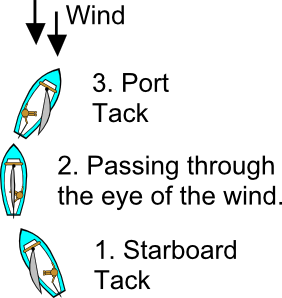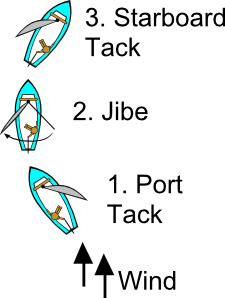I will apologize ahead of time for the sailing jargon that is about to come your way, but without it, this yarn would have been difficult to spin.
Sailors spin yarns. Some spin grandiose yarns, and some retell the same stories over and over. What these yarns teach you is that in sailing the unpredictable and unexpected will occur. To prepare, you listen to experienced sailors as they spin yarns about troubles on the water. You ask questions. You read books about tales of ingenuity and feats of great character and resourcefulness. You may watch YouTube clips or browse the Internet in search of harrowing experiences. You can also pose situations to yourself and troubleshoot theoreticals. But to tell you the truth, nothing prepares you for an event as much as the event itself.
I had not been sailing in a while when a friend invited me to join him and the owner of the boat for a Sunday sail. While I was a bit nervous about predicted heavy winds, I thought, as I usually do, if the skipper is comfortable going out, then we will all be okay.
On my way to the clubhouse, I thought about the shiftiness of the wind, the lulls and gusts I saw cascading through the streets, causing flags in close proximity to fly in different directions. I figured that perhaps the buildings were causing interference.
As we set up the rigging, I worried about my already slightly queasy stomach on the big waves caused by a passing storm. Normally on days with larger waves, my stomach can throw a bit of a fit, so with a queasy stomach, I wondered how I would fare. I also planned for leaning over the side. One of the great things about sailing and being sick is that you have the water right there. No need to worry about a mess.
Finally, the four of us were off, the owner (a Frenchman), my friend (a British-Belgian), an experienced sailor (a Korean) who was at the helm, and myself (an American). All on board had more experience than I did, and the mix of languages being spoken among the crew was quite fascinating, sometimes instructions or observations were repeated three times, once in each language.
On this small keel, duties were as such: helmsman took the main, the owner took the jib, and the friend who invited me took the gennaker. My hands were empty, so I focused on shifting my weight with the gusts of wind and staying out of the way of working sailors.
I admired the setup of the rigging on the little Open 5.70. It could easily be single-handed, similar to a dinghy.
As we sailed further and further from the buildings and shore, the waves grew bigger, the sky a tad darker, and the wind slightly heavier. Gusts would come regularly putting more and more pressure on this small keel boat, but our helmsman kept us at a comfortable heel. We flew the gennaker to take on a little more speed.
“Watch the bowsprit as it works with the gennaker, and you will get to see the wonder that is carbon,” my friend directed me.
I watched the elasticity of the bowsprit as the wind hit the gennaker and the bowsprit curved, and I began to wonder what would happen if the bowsprit broke. It seemed like it could be slightly dangerous, but we would probably quickly drop the gennaker and take care of any issues which might accompany a flying bowsprit. I also decided that troubleshooting issues like this while underway might not be the best thing. Though emergency preparedness is important, I am also superstitious.
I shifted my attention from the bowsprit to the gennaker trim, watching as the sail curled ever so gently when properly trimmed. Trying to understand the amount of pressure that was on the sail. With every gust, the trimmer shifted and adjusted the sail trim, and you could hear the gennaker sheet groan as it moved through the blocks. I did not pay much attention to the mainsail or main trim. A flying yellow gennaker against a grey and darkening sky is quite poetic.
As I silently waxed poetic, happy that my stomach was behaving, we lunged over a wave. A gust caught our sails. We kept sailing, and the gennaker was adjusted to the wind. We all shifted in our seats. Another gust, another adjustment, another shift.
A stronger gust, the boat heeled. We started to adjust and shift.
“Crack!”
Within a split second after the gust, the sails we had been looking at lay in the water. The mast was down.
As quickly as it happened everyone grabbed something.
The owner grabbed the mast, trying to counterbalance its weight, and keep it from sliding completely into the water. I grabbed for the boom, not really sure what was going to happen but knowing that we had to hold on to the rigging.
As the rest of the crew communicated in a mix of French and Korean, I tried to understand how to help and pulled with the rest to try and get the mainsail out of the water.
As soon as the sails were down, and I saw the bare hull, I knew my stomach was doomed. With nothing to take my attention, and not wanting to get in the way, I was doing as told. I was not focused on more than holding a sail and confirming that yes, the mast had broken not just once but twice, preventing the mainsail from easy removal. The helmsman worked on getting the sail apart from the top fragment of the mast, and I sat there taking deep breaths trying to decide which direction I would yak when it finally came to that.
In the end, I turned around and retched off the side of the boat, not letting go of the sail, though there was not much pressure on it. As the skipper and crew salvaged the wreckage of a broken mast, I let loose the contents of my stomach into the seas outside of Busan.
After the retching episode, I did all that I could. I untied the cunningham as directed. I helped communicate that the lower part of the sail had to come up off of the mast rather than down. I did my best to watch the different things happening around me and help others stay safe. The scariest of which was in the maneuvering of the broken mast, the snarled middle part almost hitting the helmsman in the head. Finally, I helped get the furled jib back on the boat.
After we arranged the wreckage inside the hull on the starboard side, I sat in the middle of the boat and held onto the boom as we zoomed back to the marina with our little outboard motor.
No, zoom is not the right word, but we did slightly better than putter.
There was a brief discussion about a possible fuel shortage. A small container filled about a quarter of the way came out of the hold. None of us felt that was very promising, so further discussion resulted in two oars making an appearance. I was happy to see that while fuel planning might have been optimistic, other plans took being stranded out at sea a bit more seriously.
As we motored in, because I previously had considered sailing the ship solo, I asked myself, “How would I have dealt with this situation single-handedly?”
I don’t think it would have been impossible, but it would not have been as fast as this crew working together, of course.
Then my friend posed me a question, “What would you do [with a dismasted ship] if you didn’t have an outboard motor or oars?”
My immediate reaction, as I looked toward Haeundae Beach and all the buildings was that I would set off a flare, and then he clarified, “Out on the open sea, miles from land.”
In that moment, I could not wrap my head around the question. I just was not sure, but as he answered stating that you would have to salvage what you could and make due, I realized that yes, that is exactly what would need to happen. Get your wits about you, and set about troubleshooting and jerry-rigging your mast so you can have some kind of sail.
It just goes to show that if you are sailing on open water, you should have a toolkit and other spare things lying around that can help you in dire straits.



